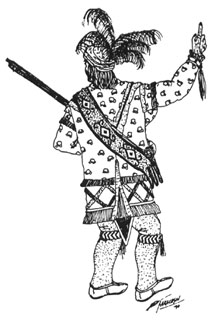NativeTech: Native American Technology and Art

The Seminole Longshirt
The Seminole Longshirt
by M. E. (Pete) Thompson
and Rick Obermeyer
in 19th Century Seminole Men`s Clothing
Rick Obermeyer ~ Editor
"In council, the ceremonial dress of the chiefs heightened the impact of their language." Page 123, Mahon, 1967.
"...(Osceola`s) dress was chiefly of calicos," George Catlin, quoted by Goggin, 1955.
"(Osceola at time of capture)... dress`d in a blue calico shirt, leggings of red cloth with a row of buttons on the outside of the leg & a red print shawl wrapp`d around his head and another his neck and shoulders." N. S. Jarvis, quoted by Goggin, 1955
(Billy Bowlegs 1852 visit to Washington) "Billy is himself a short, stout-built and quite ordinary looking man of about forty years of age and was clad in a calico frock, leggings, and a belt or two and a sort of short cloak." newspaper account, quoted by Covington, 1982
(Billy Bowlegs III, ca. 1895) "His dress was the holiday attire of the tribe, his tunic or shirt he had made himself, was highly decorated with bands of narrow red,..." Moore-Willson, 1911
| |
INTRODUCTION
The long shirt is the outer garment worn over the plain shirt. With very few exceptions, it was for everyday wear, as well as at public functions. From photographic evidence, such as contemporary postcards, it continued in common use until at least the 1910's, when both it and the plain shirt were superseded by the big shirt with its varicolored bands.
Its name among the Mikasuki is "FOK'-SHI BAX-KI" ("shirt long"). The Muscogean Creek used two names: "KA'BUH" from Spanish "capo" ("cape"), and "YOKOF'KI CHAPKO" ("shirt long"). It's often erroneously referred to as a "hunting coat" or even as a "great coat." Modern Seminoles often call it a "medicine man's coat," probably because their conservative medicine men continued to wear it to the Green Corn Dances long after it was no longer commonly used for daily wear.

CLICK IMAGE FOR PHOTO DETAIL
USE YOUR BACK BUTTON TO RETURN TO THIS PAGE
Although one might wonder why it would be worn on hot summer days, it served as an additional buffer against stinging or biting insects and thorny undergrowth. Like the plain shirt, more than one at a time might be worn in cold weather. It was almost always worn open in front, made without any fastenings, although modern examples have a tie at the throat.
Its style, originally copied from the cut of the 18th century British army matchcoat, has remained remarkably unchanged for 200 years. Only a couple of its main parts and construction steps are different between the earliest known examples and some made in the 1980's. The significant stylistic changes over that long a period of time were in kinds and placement of applique and ruffles, the finishing details. For that reason, these instructions are in two parts: general construction, and finishing Read both parts before starting because most of the finishing has to be completed in the middle of the general construction.
RESOURCES
There Just aren't a lot of longshirt examples reliably dated before 1850 to examine for putting together these instructions. And, the reverse sides of even fewer were available for study. Still, the extreme conservatism of Seminole lifestyle and dress through the 1890's hopefully makes it possible to project backwards to earlier in the same century. If many details between an 1830's example and an 1890's example can be compared and found to be the same, it is easy to assume that many other details of an 1890's example are very much the same as unknown details on 1830's example.


CLICK IMAGE FOR PHOTO DETAIL
USE YOUR BACK BUTTON TO RETURN TO THIS PAGE
We did use caution in making those logical leaps. Some construction details included here are the outcome of discussion and debate between amateur researchers, and are subject to adjustment or correction as more definitive information becomes available. For that reason, the re-enactor should keep in mind that these aren't necessarily iron-clad definitive descriptions. Observations of characteristics noted here should be tempered with "usually" or "generally" or "often" or even only "apparently." The word "always" is used here very carefully.


CLICK IMAGE FOR PHOTO DETAIL
USE YOUR BACK BUTTON TO RETURN TO THIS PAGE
Seminole styles were conservative, but that doesn't mean they were rigid or frozen unchanging. Styles did evolve, so that a re-enactor might have several choices of detail within the forms of a style period. We've tried to indicate some ranges of choice within this outline, even though for convenience the construction illustrated details only a single combination of them.
A re-enactor who is unable to study museum examples of long shirts still has three very good resources. They are Fundaburk's "Southeastern Indians Life Portraits," Sturtevant's 1956 "Osceola's Coats?" and the McKenney-Hall Portrait Gallery. There is a standing 1850's photo of Billy Bowlegs that is helpful, but the line engraving of him in Fundaburk is accurate in most details. While out of print Fundaburk is available in almost any library. (References here to specific pictures in it will be noted as "SLIP#." McKenney-Hall is also in any library, and is available in reprint for about $18.00.
Go On to Longshirt Pattern & Construction
Go to Longshirt Finishing
Go to Longshirt Appendices & References
Complete Index to Articles in 19th Century Seminole Mens Clothing
Contributed by Rick Obermeyer E-mail: orick@prodigy.net
From the book 19th Century Seminole Mens Clothing
© 1991-2000 Sherwood F. Obermeyer Jr., 2124 Miscindy Place, Orlando, FL 32806
Return to NativeTech's Main Leather & Clothes Menu
Leather & Clothes Bibliography and Books to Buy On-Line
|

|
Text and Graphics
© 1994 -
Tara Prindle
unless otherwise cited.
|






